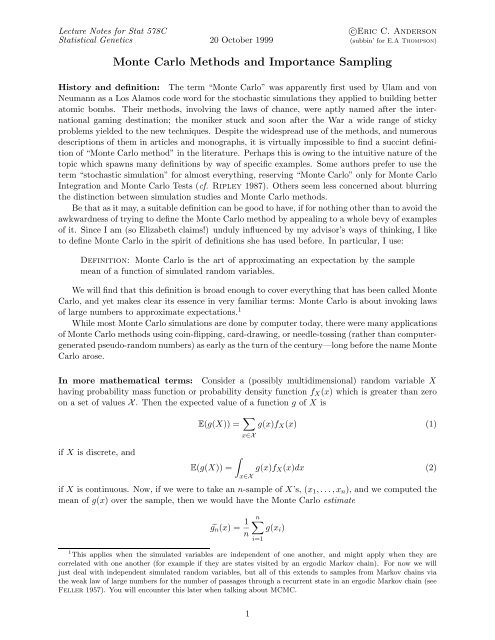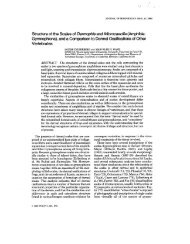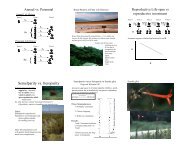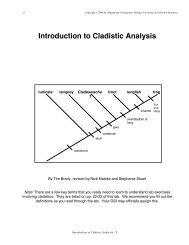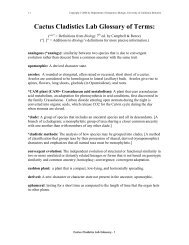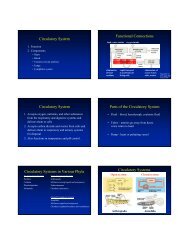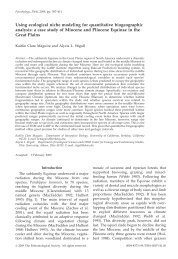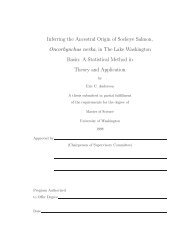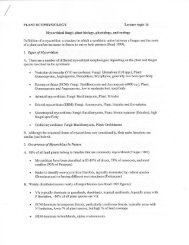Monte Carlo Methods and Importance Sampling
Monte Carlo Methods and Importance Sampling
Monte Carlo Methods and Importance Sampling
You also want an ePaper? Increase the reach of your titles
YUMPU automatically turns print PDFs into web optimized ePapers that Google loves.
Lecture Notes for Stat 578C c○Eric C. Anderson<br />
Statistical Genetics 20 October 1999 (subbin’ for E.A Thompson)<br />
<strong>Monte</strong> <strong>Carlo</strong> <strong>Methods</strong> <strong>and</strong> <strong>Importance</strong> <strong>Sampling</strong><br />
History <strong>and</strong> definition: The term “<strong>Monte</strong> <strong>Carlo</strong>” was apparently first used by Ulam <strong>and</strong> von<br />
Neumann as a Los Alamos code word for the stochastic simulations they applied to building better<br />
atomic bombs. Their methods, involving the laws of chance, were aptly named after the international<br />
gaming destination; the moniker stuck <strong>and</strong> soon after the War a wide range of sticky<br />
problems yielded to the new techniques. Despite the widespread use of the methods, <strong>and</strong> numerous<br />
descriptions of them in articles <strong>and</strong> monographs, it is virtually impossible to find a succint definition<br />
of “<strong>Monte</strong> <strong>Carlo</strong> method” in the literature. Perhaps this is owing to the intuitive nature of the<br />
topic which spawns many definitions by way of specific examples. Some authors prefer to use the<br />
term “stochastic simulation” for almost everything, reserving “<strong>Monte</strong> <strong>Carlo</strong>” only for <strong>Monte</strong> <strong>Carlo</strong><br />
Integration <strong>and</strong> <strong>Monte</strong> <strong>Carlo</strong> Tests (cf. Ripley 1987). Others seem less concerned about blurring<br />
the distinction between simulation studies <strong>and</strong> <strong>Monte</strong> <strong>Carlo</strong> methods.<br />
Be that as it may, a suitable definition can be good to have, if for nothing other than to avoid the<br />
awkwardness of trying to define the <strong>Monte</strong> <strong>Carlo</strong> method by appealing to a whole bevy of examples<br />
of it. Since I am (so Elizabeth claims!) unduly influenced by my advisor’s ways of thinking, I like<br />
to define <strong>Monte</strong> <strong>Carlo</strong> in the spirit of definitions she has used before. In particular, I use:<br />
Definition: <strong>Monte</strong> <strong>Carlo</strong> is the art of approximating an expectation by the sample<br />
mean of a function of simulated r<strong>and</strong>om variables.<br />
We will find that this definition is broad enough to cover everything that has been called <strong>Monte</strong><br />
<strong>Carlo</strong>, <strong>and</strong> yet makes clear its essence in very familiar terms: <strong>Monte</strong> <strong>Carlo</strong> is about invoking laws<br />
of large numbers to approximate expectations. 1<br />
While most <strong>Monte</strong> <strong>Carlo</strong> simulations are done by computer today, there were many applications<br />
of <strong>Monte</strong> <strong>Carlo</strong> methods using coin-flipping, card-drawing, or needle-tossing (rather than computergenerated<br />
pseudo-r<strong>and</strong>om numbers) as early as the turn of the century—long before the name <strong>Monte</strong><br />
<strong>Carlo</strong> arose.<br />
In more mathematical terms: Consider a (possibly multidimensional) r<strong>and</strong>om variable X<br />
having probability mass function or probability density function fX(x) which is greater than zero<br />
on a set of values X . Then the expected value of a function g of X is<br />
E(g(X)) = <br />
g(x)fX(x) (1)<br />
if X is discrete, <strong>and</strong><br />
<br />
E(g(X)) =<br />
x∈X<br />
x∈X<br />
g(x)fX(x)dx (2)<br />
if X is continuous. Now, if we were to take an n-sample of X’s, (x1,...,xn), <strong>and</strong> we computed the<br />
mean of g(x) over the sample, then we would have the <strong>Monte</strong> <strong>Carlo</strong> estimate<br />
gn(x) = 1<br />
n<br />
n<br />
g(xi)<br />
1 This applies when the simulated variables are independent of one another, <strong>and</strong> might apply when they are<br />
correlated with one another (for example if they are states visited by an ergodic Markov chain). For now we will<br />
just deal with independent simulated r<strong>and</strong>om variables, but all of this extends to samples from Markov chains via<br />
the weak law of large numbers for the number of passages through a recurrent state in an ergodic Markov chain (see<br />
Feller 1957). You will encounter this later when talking about MCMC.<br />
1<br />
i=1
2 c○Eric C. Anderson. You may duplicate this freely for pedagogical purposes.<br />
of E(g(X)). We could, alternatively, speak of the r<strong>and</strong>om variable<br />
gn(X) = 1<br />
n<br />
n<br />
g(X)<br />
which we call the <strong>Monte</strong> <strong>Carlo</strong> estimator of E(g(X)).<br />
If E(g(X)), exists, then the weak law of large numbers tells us that for any arbitrarily small ɛ<br />
i=1<br />
lim<br />
n→∞ P (| gn(X) − E(g(X))| ≥ɛ) =0.<br />
This tells us that as n gets large, then there is small probability that gn(X) deviates much from<br />
E(g(X)). For our purposes, the strong law of large numbers says much the same thing—the<br />
important part being that so long as n is large enough, gn(x) arising from a <strong>Monte</strong> <strong>Carlo</strong> experiment<br />
shall be close to E(g(X)), as desired.<br />
One other thing to note at this point is that gn(X) is unbiased for E(g(X)):<br />
E( gn(X)) = E<br />
<br />
1<br />
n<br />
n<br />
<br />
g(Xi)<br />
i=1<br />
= 1<br />
n<br />
n<br />
E(g(Xi)) = E(g(X)).<br />
Making this useful: The preceding section comes to life <strong>and</strong> becomes useful when one realizes<br />
that very many quantities of interest may be cast as expectations. Most importantly for applications<br />
in statistical genetics, it is possible to express all probabilities, integrals, <strong>and</strong> summations as<br />
expectations:<br />
Probabilities: Let Y be a r<strong>and</strong>om variable. The probability that Y takes on some value in a set A<br />
can be expressed as an expectation using the indicator function:<br />
i=1<br />
P (Y ∈ A) =E(I {A}(Y )) (3)<br />
where I {A}(Y ) is the indicator function that takes the value 1 when Y ∈ A <strong>and</strong> 0 when Y ∈ A.<br />
Integrals: Consider a problem now which is completely deterministic—integrating a function q(x)<br />
from a to b (as in high-school calculus). So we have b<br />
a q(x)dx. This can be expressed as an<br />
expectation with respect to a uniformly distributed, continuous r<strong>and</strong>om variable U between<br />
a <strong>and</strong> b. U has density function fU(u) =1/(b − a), so if we rewrite the integral we get<br />
(b − a)<br />
b<br />
a<br />
q(x) 1<br />
dx =(b− a)<br />
b − a<br />
x∈A<br />
b<br />
a<br />
q(x)fU(x)dx =(b − a)E(q(U)) ...voila!<br />
Discrete Sums: The discrete version of the above is just the sum of a function q(x) over the countably<br />
many values of x in a set A. If we have a r<strong>and</strong>om variable W which takes values in A all<br />
with equal probability p (so that <br />
w∈A p = 1 then the sum may be cast as the expectation<br />
<br />
q(x) = 1 <br />
q(x)p =<br />
p<br />
1<br />
E(q(W )).<br />
p<br />
x∈A<br />
The immediate consequence of this is that all probabilities, integrals, <strong>and</strong> summations can be<br />
approximated by the <strong>Monte</strong> <strong>Carlo</strong> method. A crucial thing to note, however, is that there is no<br />
restriction that says U or W above must have uniform distributions. This is just for easy illustration<br />
of the points above. We will explore this point more while considering importance sampling.
c○Eric C. Anderson. Corrections, comments?=⇒eriq@cqs.washington.edu 3<br />
Example I: Approximating probabilities by <strong>Monte</strong> <strong>Carlo</strong>. Consider a Wright-Fisher<br />
population of size N diploid individuals in which Xt counts the numbers of copies of a certain<br />
allelic type in the population at time t. At time zero, there are x0 copies of the allele. Given<br />
this, what is the probability that the allele will be lost from the population in t generations,<br />
i.e., P (Xt =0|X0 = x0)? This can be computed exactly by multiplying transition probability<br />
matrices together, or by employing the Baum (1972) algorithm (which you will learn about<br />
later), but it can also be approximated by <strong>Monte</strong> <strong>Carlo</strong>. It is simple to simulate genetic drift in<br />
a Wright-Fisher population; thus we can easily simulate values for Xt given X0 = x0. Then,<br />
P (Xt =0|X0 = x0) =E(I {0}(Xt)|X0 = x0)<br />
where I {0}(Xt) takes the value 1 when Xt = 0 <strong>and</strong> 0 otherwise. Denoting the i th simulated<br />
value of Xt by x (i)<br />
t our <strong>Monte</strong> <strong>Carlo</strong> estimate would be<br />
P (Xt =0|X0 = x0) ≈ 1<br />
n<br />
n<br />
i=1<br />
I {0}(x (i)<br />
t ).<br />
Example II: <strong>Monte</strong> <strong>Carlo</strong> approximations to distributions. A simple extension of the<br />
above example is to approximate the whole probability distribution P (Xt|X0 = x0) by <strong>Monte</strong><br />
<strong>Carlo</strong>. Consider the histogram below:<br />
<strong>Monte</strong> <strong>Carlo</strong> Estimate of Probability<br />
0.04<br />
0.03<br />
0.02<br />
0.01<br />
0<br />
0 20 40 60 80 100 120 140 160 180 200<br />
Number of Copies of Allele<br />
It represents the results of simulations in which n =50, 000, x0 = 60, t = 14, the Wright-Fisher<br />
population size N = 100 diploids, <strong>and</strong> each rectangle represents a <strong>Monte</strong> <strong>Carlo</strong> approximation to<br />
P (a ≤ X14
4 c○Eric C. Anderson. You may duplicate this freely for pedagogical purposes.<br />
The term following the last equals sign is the sum over all x of a function of x [namely, P (Y =<br />
y|X = x)], weighted by the marginal probabilities P (X = x). Clearly this is an expectation,<br />
<strong>and</strong> therefore may be approximated by <strong>Monte</strong> <strong>Carlo</strong>, giving us<br />
P (Y = y) ≈ 1<br />
n<br />
n<br />
P (Y = y|X = xi)<br />
i=1<br />
where xi is the i th realization from the marginal distribution of X. You will see this sort of<br />
thing many times again in Stat 578C.<br />
OK, these examples have all been presented as if the application of <strong>Monte</strong> <strong>Carlo</strong> to practically<br />
any problem is a soporific <strong>and</strong> trivial exercise. However, nothing could be further from the truth!<br />
Though it is typically easy to formulate a quantity as an expectation <strong>and</strong> to propose a “naive” <strong>Monte</strong><br />
<strong>Carlo</strong> estimator, it is quite another thing to actually have the <strong>Monte</strong> <strong>Carlo</strong> estimator provide you<br />
with good estimates in a reasonable amount of computer time. For most problems, a number of<br />
<strong>Monte</strong> <strong>Carlo</strong> estimators may be proposed, however some <strong>Monte</strong> <strong>Carlo</strong> estimators are clearly better<br />
than others. Typically, a “better” <strong>Monte</strong> <strong>Carlo</strong> estimator has smaller variance (for the same amount<br />
of computational effort) than its competitors. Thus we turn to matters of. . .<br />
<strong>Monte</strong> <strong>Carlo</strong> variance: Going back to our original notation, we have the r<strong>and</strong>om variable gn(X),<br />
a <strong>Monte</strong> <strong>Carlo</strong> estimator of E(g(X)). Like all r<strong>and</strong>om variables, we may compute its variance (if it<br />
exists) by the st<strong>and</strong>ard formulas:<br />
<br />
n<br />
<br />
1<br />
Var( gn(X))=Var g(Xi)<br />
n<br />
if X is discrete, <strong>and</strong><br />
Var( gn(X))=Var<br />
<br />
1<br />
n<br />
i=1<br />
n<br />
<br />
g(Xi)<br />
i=1<br />
= Var(g(X))<br />
n<br />
= Var(g(X))<br />
n<br />
= 1<br />
n<br />
<br />
[g(x) − E(g(X))] 2 fX(x) (5)<br />
x∈X<br />
= 1<br />
<br />
[g(x) − E(g(X))]<br />
n x∈X<br />
2 fX(x)dx (6)<br />
if X is continuous. From here on out, let us do everything in terms of integrals over continuous<br />
variables, but it all applies equally well to sums over discrete r<strong>and</strong>om variables. There are numerous<br />
ways to reduce the variance of <strong>Monte</strong> <strong>Carlo</strong> estimators. Of these “variance-reduction” techniques,<br />
the one called “importance sampling” is particularly useful. I find that it is best introduced by<br />
describing its antithesis which I call “irrelevance sampling” or “barely relevant sampling,” which<br />
we will turn to after a short digression.<br />
Digression 1: Estimating Var(gn(X)): Since, typically E(gn(X)) in (5) or (6) is unknown <strong>and</strong><br />
the sum or the integral is not feasibly computed (that is why we would be doing <strong>Monte</strong> <strong>Carlo</strong> in<br />
the first place) the formulas in (5) <strong>and</strong> (6) are not useful for estimating the variance associated<br />
with your <strong>Monte</strong> <strong>Carlo</strong> estimate when you are actually doing <strong>Monte</strong> <strong>Carlo</strong>. Instead, just like<br />
approximating the variance from a sample à la our earliest statistics classes, we have an unbiased<br />
estimator for Var(g(X)):<br />
Var(g(X)) = 1<br />
n − 1<br />
n<br />
(g(xi) − gn(x)) 2<br />
(This is just the familiar s 2 from Statistics 1). The unbiased estimate of the variance of gn(X)<br />
is 1/n of that:<br />
Var(gn(X)) = Var(g(X))<br />
n<br />
=<br />
i=1<br />
1<br />
n(n − 1)<br />
(7)<br />
n<br />
(g(xi) − gn(x)) 2 . (8)<br />
i=1
c○Eric C. Anderson. Corrections, comments?=⇒eriq@cqs.washington.edu 5<br />
The form given in (8) is not particularly satisfying if one does not want to wait until the end of<br />
the simulation (until n is reached) to compute the variance. To this end, the following formulas<br />
are extremely useful: The mean can be computed on the fly, recursively by:<br />
gn+1(x) = 1<br />
n +1 (ngn(x)+g(xn+1)). (9)<br />
If we also expend the effort to record the sum of the squares of the g(x)’s, SSgn = n<br />
i=1 [g(xi)] 2 ,<br />
then a simple calculation gives Var(gn(X)):<br />
Var(gn(X)) = 1<br />
n<br />
<br />
1<br />
n<br />
2<br />
SSgn − (gn(x))<br />
n − 1 n − 1<br />
<br />
. (10)<br />
When programming in a language like C, using zero-base subscripting, I often confuse myself<br />
trying to implement the above recursion <strong>and</strong> formulas. So, primarily for my own benefit, (though<br />
this may be a useful reference for you if you program in C or C ++ ) I include a code snippet for<br />
implementing the above:<br />
// variable declarations<br />
double i; // the index for counting number of reps (declaring as double<br />
// avoids having to cast it to a double all the time)<br />
double gx; // the values that will be realized<br />
double mean_gx; // the <strong>Monte</strong> <strong>Carlo</strong> average that we will accumulate (our <strong>Monte</strong> <strong>Carlo</strong> estimate)<br />
double ss_gx; // the sum of squares of gx<br />
double var_of_mean_gx; // the estimate of our monte carlo variance<br />
// variable initializations:<br />
mean_gx = 0.0; ss_gx = 0.0;<br />
// loop over the index i. these are repetitions in the simulation:<br />
for(i=0.0;i0) {<br />
var_of_mean_gx = (ss_gx - (i+1.0)*(mean_gx * mean_gx) ) / (i * (i+1.0) );<br />
// above is the current estimate of the variance of our <strong>Monte</strong> <strong>Carlo</strong> estimator<br />
}<br />
}<br />
Barely relevant sampling: Back to the task at h<strong>and</strong>. To introduce importance sampling we<br />
consider its opposite. Imagine that we want a <strong>Monte</strong> <strong>Carlo</strong> approximation to 1<br />
0 g(x)dx for g(x)<br />
shown in the figure below. Note that g(x) =0forx1.<br />
1<br />
0<br />
1.75 g(x)<br />
1.5<br />
1.25<br />
1<br />
0.75<br />
0.5<br />
0.25<br />
density of a Uniform(0, 1) r.v.<br />
density of a Uniform(0, 5) r.v.<br />
1 2 3 4 5<br />
If<br />
<br />
we have U ∼ Uniform(0, 1), then we can cast the integral as the expectation with respect to U:<br />
1<br />
1 n 0 g(x)dx = E(g(U)), so we may approximate it by <strong>Monte</strong> <strong>Carlo</strong>: n 1 g(ui). This would work<br />
reasonably well.<br />
The figure, however, suggests another possibility. One could use W ∼ Uniform(0, 5) giving<br />
5 n g(x)dx =5· E(g(W )) <strong>and</strong> hence the <strong>Monte</strong> <strong>Carlo</strong> estimator n 1 g(wi). Obviously such a
6 c○Eric C. Anderson. You may duplicate this freely for pedagogical purposes.<br />
course would make no sense at all because, on average, 80% of the realized wi’s would tell you<br />
nothing substantial about the integral of g(x) since g(x) = 0 for 1
# out of 5,000<br />
300<br />
250<br />
200<br />
150<br />
100<br />
0.4<br />
0.3<br />
0.2<br />
0.1<br />
-6 -4 -2 2 4 6<br />
50<br />
0<br />
1.5<br />
# out of 5,000<br />
0.4<br />
0.3<br />
0.2<br />
0.1<br />
-6 -4 -2 2 4 6<br />
2000<br />
1800<br />
1600<br />
1400<br />
1200<br />
1000<br />
800<br />
600<br />
400<br />
200<br />
0<br />
1.5<br />
# out of 5,000<br />
0.4<br />
0.3<br />
0.2<br />
0.1<br />
-6 -4 -2 2 4 6<br />
3000<br />
2500<br />
2000<br />
1500<br />
1000<br />
500<br />
0<br />
0 whenever g(x) = 0<br />
2. h(x) should be close to being proportional to |g(x)|<br />
3. it should be easy to simulate values from h(x)<br />
4. it should be easy to compute the density h(x) for any value x that you might realize.<br />
Fulfilling this wish-list in high dimensional space (where <strong>Monte</strong> <strong>Carlo</strong> techniques are most useful)<br />
is quite often a tall task, <strong>and</strong> can provide hours of entertainment, not to mention dissertation<br />
chapters, etc.<br />
Note also that g(x) is any arbitrary function, so it certainly includes the integr<strong>and</strong> of a st<strong>and</strong>ard<br />
expectation. For example, with X ∼ fX we might be interested in E(r(X)) for some function r so<br />
we could use<br />
<br />
<br />
r(x)fX(x)<br />
r(x)fX(x)<br />
E(r(X)) = r(x)fX(x)dx =<br />
h(x) =Eh<br />
h(x)<br />
h(x)<br />
<strong>and</strong> then go searching about for a suitable h(x) that is close to proportional to r(x)fX(x).<br />
Example VI: Latent variables <strong>and</strong> importance sampling Going back to Example III<br />
with the discrete sum over latent variables X it is clear that the optimal importance sampling<br />
function would be the conditional distribution of X given Y , i.e.,<br />
P (Y = y) = <br />
P (Y = y, X = x) = <br />
x∈X<br />
x∈X<br />
P (Y = y, X = x)<br />
P (X|Y = y).<br />
P (X|Y = y)<br />
>1.5
8 c○Eric C. Anderson. You may duplicate this freely for pedagogical purposes.<br />
# out of 5,000<br />
1200<br />
1000<br />
800<br />
600<br />
400<br />
200<br />
0<br />
1.5).<br />
Note that the right side is a conditional expectation of a function of X. As before P (X|Y )is<br />
not computable. So one must turn to finding some other distribution, say P ∗ (X), that is close<br />
to P (X|Y ) but which is more easily sampled from <strong>and</strong> computed.<br />
A common pitfall of importance sampling: As a final word on importance sampling, it<br />
should be pointed out that the tails of the distributions matter! While h(x) might be roughly the<br />
same shape as g(x), serious difficulties arise if h(x) gets small much faster than g(x) out in the<br />
tails. In such a case, though it is improbable (by definition) that you will realize a value xi from<br />
the far tails of h(x), if you do, then your <strong>Monte</strong> <strong>Carlo</strong> estimator will take a jolt—g(xi)/h(xi) for<br />
such an improbable xi may be orders of magnitude larger than the typical values g(x)/h(x) that<br />
you see.<br />
As an example of this phenomenon, investigate Figure 2 which shows the histogram of 5,000<br />
<strong>Monte</strong> <strong>Carlo</strong> estimates of the area between -50 <strong>and</strong> 50 of a t1 density (truncated at -50 <strong>and</strong> 50<br />
<strong>and</strong> renormalized so the exact area is 1). The importance sampling function used for this was a<br />
st<strong>and</strong>ard, unit normal density, which obviously gets small in the tails much faster than a cauchy<br />
(see Figure 1(b)). Note in particular that about 15 of the 5,000 <strong>Monte</strong> <strong>Carlo</strong> estimates were greater<br />
than 1.5!<br />
Further reading: A classic reference on <strong>Monte</strong> <strong>Carlo</strong> is Hammersley <strong>and</strong> H<strong>and</strong>scomb (1964).<br />
They describe several other variance-reduction techniques that you might find interesting.<br />
References<br />
Baum, L. E., 1972 An inequality <strong>and</strong> associated maximization technique in statistical estimation for<br />
probabilistic functions of Markov processes. In O. Shisha (Ed.), Inequalities–III: Proceedings of the Third<br />
Symposium on Inequalities Held at the University of California, Los Angeles, September 1–9, 1969, pp.<br />
1–8. New York: Academic Press.<br />
Feller, W., 1957 An Introduction to Probability Theory <strong>and</strong> Its Applications, 2nd Edition. New York:<br />
John Wiley & Sons.<br />
Hammersley, J. M. <strong>and</strong> D. C. H<strong>and</strong>scomb, 1964 <strong>Monte</strong> <strong>Carlo</strong> <strong>Methods</strong>. London: Methuen & Co Ltd.<br />
Ripley, B. D., 1987 Stochastic Simulation. New York: Wiley & Sons.<br />
Rubinstein, B. Y., 1981 Simulation <strong>and</strong> the <strong>Monte</strong> <strong>Carlo</strong> Method. New York: Wiley & Sons.<br />
>1.5


